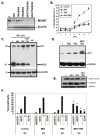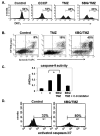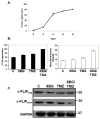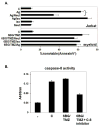Temozolomide-mediated DNA methylation in human myeloid precursor cells: differential involvement of intrinsic and extrinsic apoptotic pathways
- PMID: 23536437
- PMCID: PMC3711223
- DOI: 10.1158/1078-0432.CCR-12-2671
Temozolomide-mediated DNA methylation in human myeloid precursor cells: differential involvement of intrinsic and extrinsic apoptotic pathways
Abstract
Purpose: An understanding of how hematopoietic cells respond to therapy that causes myelosuppression will help develop approaches to prevent this potentially life-threatening toxicity. The goal of this study was to determine how human myeloid precursor cells respond to temozolomide (TMZ)-induced DNA damage.
Experimental design: We developed an ex vivo primary human myeloid precursor cells model system to investigate the involvement of cell-death pathways using a known myelosuppressive regimen of O(6)-benzylguanine (6BG) and TMZ.
Results: Exposure to 6BG/TMZ led to increases in p53, p21, γ-H2AX, and mitochondrial DNA damage. Increases in mitochondrial membrane depolarization correlated with increased caspase-9 and -3 activities following 6BG/TMZ treatment. These events correlated with decreases in activated AKT, downregulation of the DNA repair protein O(6)-methylguanine-DNA methyltransferase (MGMT), and increased cell death. During myeloid precursor cell expansion, FAS/CD95/APO1(FAS) expression increased over time and was present on approximately 100% of the cells following exposure to 6BG/TMZ. Although c-flipshort, an endogenous inhibitor of FAS-mediated signaling, was decreased in 6BG/TMZ-treated versus control, 6BG-, or TMZ alone-treated cells, there were no changes in caspase-8 activity. In addition, there were no changes in the extent of cell death in myeloid precursor cells exposed to 6BG/TMZ in the presence of neutralizing or agonistic anti-FAS antibodies, indicating that FAS-mediated signaling was not operative.
Conclusions: In human myeloid precursor cells, 6BG/TMZ-initiated apoptosis occurred by intrinsic, mitochondrial-mediated and not extrinsic, FAS-mediated apoptosis. Human myeloid precursor cells represent a clinically relevant model system for gaining insight into how hematopoietic cells respond to chemotherapeutics and offer an approach for selecting effective chemotherapeutic regimens with limited hematopoietic toxicity.
©2013 AACR
Conflict of interest statement
Figures





Similar articles
-
Apoptosis in malignant glioma cells triggered by the temozolomide-induced DNA lesion O6-methylguanine.Oncogene. 2007 Jan 11;26(2):186-97. doi: 10.1038/sj.onc.1209785. Epub 2006 Jul 3. Oncogene. 2007. PMID: 16819506
-
Mitochondrial targeting of human O6-methylguanine DNA methyltransferase protects against cell killing by chemotherapeutic alkylating agents.Cancer Res. 2005 Apr 15;65(8):3319-27. doi: 10.1158/0008-5472.CAN-04-3335. Cancer Res. 2005. PMID: 15833865
-
Activation of AMP-activated protein kinase by temozolomide contributes to apoptosis in glioblastoma cells via p53 activation and mTORC1 inhibition.J Biol Chem. 2010 Dec 24;285(52):40461-71. doi: 10.1074/jbc.M110.164046. Epub 2010 Sep 29. J Biol Chem. 2010. PMID: 20880848 Free PMC article.
-
Progression of O⁶-methylguanine-DNA methyltransferase and temozolomide resistance in cancer research.Mol Biol Rep. 2014 Oct;41(10):6659-65. doi: 10.1007/s11033-014-3549-z. Epub 2014 Jul 3. Mol Biol Rep. 2014. PMID: 24990698 Review.
-
Strategies to improve the killing of tumors using temozolomide: targeting the DNA repair protein MGMT.Curr Med Chem. 2012;19(23):3886-92. doi: 10.2174/092986712802002446. Curr Med Chem. 2012. PMID: 22788764 Review.
Cited by
-
A combination of metformin and epigallocatechin gallate potentiates glioma chemotherapy in vivo.Front Pharmacol. 2023 Mar 21;14:1096614. doi: 10.3389/fphar.2023.1096614. eCollection 2023. Front Pharmacol. 2023. PMID: 37025487 Free PMC article.
-
EDNRB isoform 3 confers Temozolomide resistance in A375 melanoma cells by modulating membrane potential, reactive oxygen species and mitochondrial Ca2.Cancer Manag Res. 2019 Aug 5;11:7353-7367. doi: 10.2147/CMAR.S208604. eCollection 2019. Cancer Manag Res. 2019. PMID: 31496797 Free PMC article.
-
Temozolomide for immunomodulation in the treatment of glioblastoma.Neuro Oncol. 2018 Nov 12;20(12):1566-1572. doi: 10.1093/neuonc/noy072. Neuro Oncol. 2018. PMID: 29733389 Free PMC article. Review.
-
The Impact of Epigenetic Modifications on Adaptive Resistance Evolution in Glioblastoma.Int J Mol Sci. 2021 Aug 3;22(15):8324. doi: 10.3390/ijms22158324. Int J Mol Sci. 2021. PMID: 34361090 Free PMC article. Review.
-
Advances in Preclinical/Clinical Glioblastoma Treatment: Can Nanoparticles Be of Help?Cancers (Basel). 2022 Oct 10;14(19):4960. doi: 10.3390/cancers14194960. Cancers (Basel). 2022. PMID: 36230883 Free PMC article. Review.
References
-
- Parent-Massin D, Hymery N, Sibiril Y. Stem cells in myelotoxicity. Toxicology. 2010;267:112–7. - PubMed
-
- Doulatov S, Notta F, Laurenti E, Dick JE. Hematopoiesis: a human perspective. Cell stem cell. 2012;10:120–36. - PubMed
-
- Casorelli I, Pelosi E, Biffoni M, Cerio AM, Peschle C, Testa U, et al. Methylation damage response in hematopoietic progenitor cells. DNA repair. 2007;6:1170–8. - PubMed
-
- Gerson SL, Phillips W, Kastan M, Dumenco LL, Donovan C. Human CD34+ hematopoietic progenitors have low, cytokine-unresponsive O6-alkylguanine-DNA alkyltransferase and are sensitive to O6-benzylguanine plus BCNU. Blood. 1996;88:1649–55. - PubMed
-
- Stupp R, Mason WP, van den Bent MJ, Weller M, Fisher B, Taphoorn MJ, et al. Radiotherapy plus concomitant and adjuvant temozolomide for glioblastoma. N Engl J Med. 2005;352:987–96. - PubMed
Publication types
MeSH terms
Substances
Associated data
- Actions
Grants and funding
LinkOut - more resources
Full Text Sources
Other Literature Sources
Molecular Biology Databases
Research Materials
Miscellaneous

